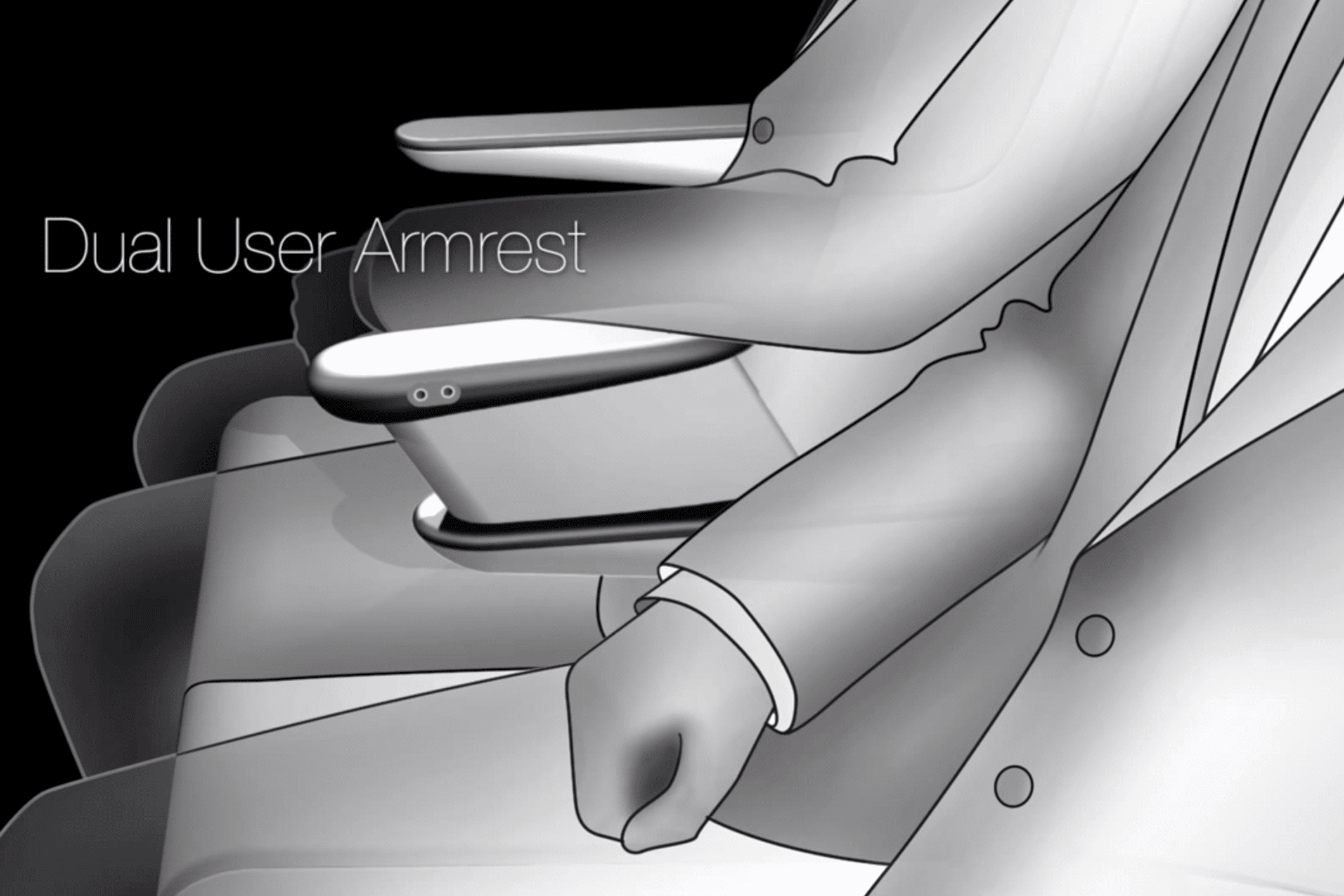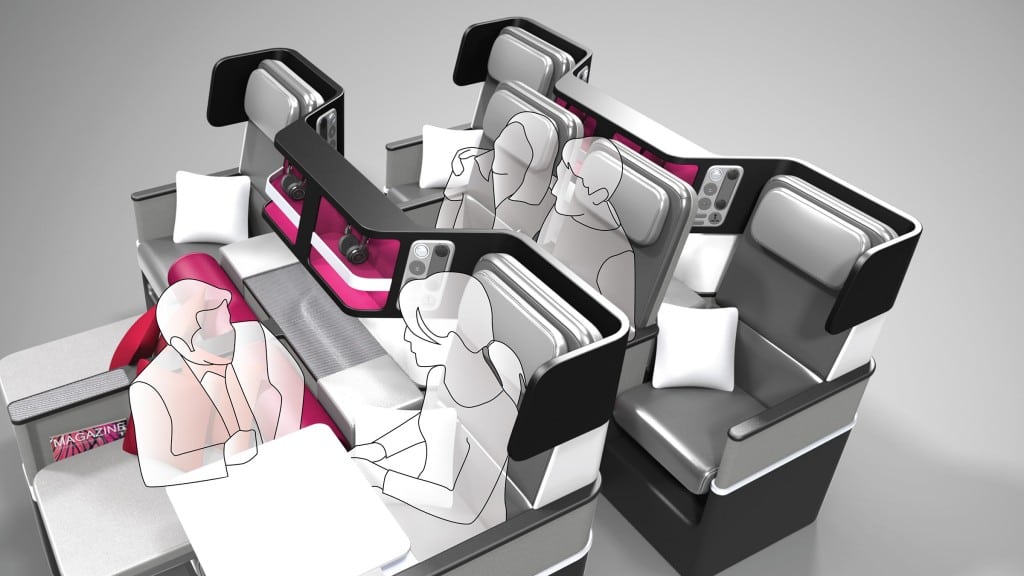Skift Take
Airlines could easily afford to retrofit all their seats with a $2 armrest fee that every flyer would be happy to pay.
The biggest battle in the air isn’t between American Air and United, or British Airways and Ryanair, or even Spirit Air and its customers.
It’s the one that happens where two coach-class seats meet.
James S.H. Lee, Director of Paperclip Design Limited, Hong Kong, has received numerous accolades for his designs and won prizes from the aviation industry’s prestigious Crystal Cabin Awards, held every year at the Aircraft Interiors Expo in Hamburg. Among other designs, he has one that could solve the battle for which flyer gets the armrest by giving one to both.
But, as anyone in aviation will tell you, good design takes time to go from the drawing board to the aircraft.
A long time.
Lee’s designs range from the simple to the sublime. For example, even as aircraft seats introduced at this year’s show eliminate armrests entirely, or others continue to have ever-narrower harder armrests, Paperclip’s design provides an easy solution to the quandary of who gets to rest their elbow.
Inspired by the paperclip’s shape, the simple armrest design provides two armrests in a single space, one above and one below, as part of a single smooth curved unit. This design won the Crystal Cabin Award in 2009, for its innovation, but it’s still no closer to getting on the aircraft today than it was when Lee first dreamed it up.
There’s a good reason for that. Any aircraft components must go through rigorous testing and evaluation, and be certified and accepted as not causing any safety risks. For this, any changes or innovations require strong backing and support by large players in the industry with the resources and capabilities to qualify those innovations.
In short, one of the big guys in seating needs to pick up on the idea and see it through. But those big players need a business incentive to change existing equipment. Without a guarantee that airlines will want a particular feature on their seat, they are unlikely to adopt the change.
Lee understands the limitations of the industry well. He tells us: “The greatest challenge to introducing design innovations in aviation is the prohibitive cost, primarily driven up by the safety and certification requirements, which is a complex field in itself and requires expert knowledge. This is not an industry where one can build something in the garage.”
And the reason for those safety and certification requirements is sound. They involve questions ranging from flammability of components to crash testing dynamics, to evacuation requirements, in addition to just proving they are practical in every day use, sturdy and easy to maintain.
Awareness of these limitations have not discouraged Lee in the least. Lee is passionate about aviation and eager to contribute. He is well qualified too, having graduated from the University of Hong Kong in Mechanical Engineering and then from MIT in Aeronautics and Astronautics, before spending time as an intern at Cathay Pacific and venturing off to give life to his design visions.
This year, Lee won the Crystal Cabin Award again. This time, for his Caterpillar Convertible Seating for Long Haul Flights. The Caterpillar allows airlines to create convertible cabin spaces which can be configured as a comfortable Premium Economy seat or quickly converted to a Business Class Suite, with its own private bed, plenty of room, and direct aisle access. It’s beautiful, functional and practical.
A convertible seating solution is often predicted as the future of cabin design by industry visionaries, and Lee’s Crystal Cabin Award is proof that the industry wants to see these innovations, but it may take quite some time before any of us get to fly on a Caterpillar.
Lee is still incredibly optimistic, and expects to find industry partners who will help his designs take-off.
“I particularly enjoy the challenges relating to the optimization of space within the tight constraints of the commercial airline cabin,” he tells us. “I suppose this obsession, combined with a mind full of random thoughts gives me the inspiration for useful new ideas once in a while, when luck hits.”
Luck hits Lee often, at least in terms of inspiration.
He has designed a highly useful premium-class seat which allows easier access to the aisle for both passengers; a Checkerboard Convertible Seat for short-haul flights which will allow airlines to install a fully convertible tourist class seating configuration; and a Meerkat Seat for long-haul economy that reduces costs, weight and maintenance for the airline, while giving the passenger extra room and plenty of leg space because of its unique design.
The Meerkat even has a rest for tablets on the food tray, a personal cabinet, a nice separate cup holder which won’t spill your drink, a handy spot to keep earphones from getting tangled, an adjustable headrest and, yes, a version of the paperclip concept so the middle armrest doesn’t become an issue.
To go from the drawing board to the clouds, though, Lee will need more than luck. An angel or two might not hurt. Or a visionary airline saying: “Hey, why can’t we have that?”
For now, Lee has limitless imagination, engineering expertise, and strong design capability on his side. And if the Paperclip does not take off, you might get to enjoy it anyway, at the theatre or on a different form of mass transit.
Lee may be a dreamer, but he’s clever enough to hedge his bets.
The Daily Newsletter
Our daily coverage of the global travel industry. Written by editors and analysts from across Skift’s brands.
Have a confidential tip for Skift? Get in touch
Tags: amenities, design, in-flight
Photo credit: Is this the solution to elbow wars? Paperclip Design / YouTube

